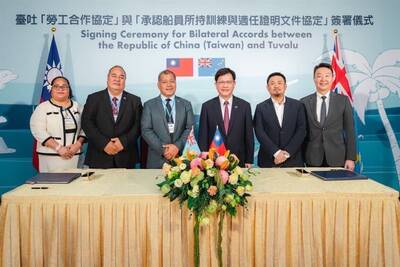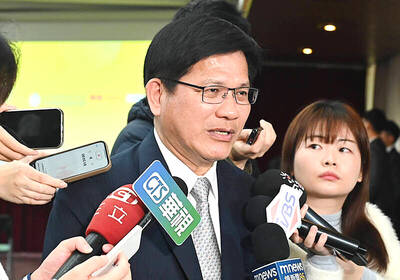National Tsing Hua University professor of materials science Yeh Jien-wei (葉均蔚), who pioneered research into high-entropy alloys, was given special coverage in the academic journal Nature for his contribution creating the next generation of alloys.
Yeh came up with the idea of high-entropy alloys in 1995, while he was driving through the Hsinchu countryside, and the idea has evolved into a fast-moving field that attracts increasingly more scientists and funding on a global scale, Yeh told a news conference held by the Ministry of Science and Technology last week.
Unlike traditional alloys, which are made by mixing a primary metal with a small amount of other elements, high-entropy alloys consist of four, five or more elements mixed together in roughly equal ratios, he said.
Pure metals have a regular atomic structure with identical layers stacked upon each other and those layers slip past each other easily, whereas mixing a metal with another element with a different atomic size can stop slipping and create a harder alloy, he said.
However, it was believed that if too much of the alloying metal was added, a regular atomic structure might be formed when atoms of the alloying and primary metals arrange themselves in a regular pattern, thereby producing a weak and brittle compound, Yeh said.
“I came up with the idea of mixing similar quantities of four or five elements, which increases the number of ways for different atoms to alternate with each other, thereby creating a disorder, or ‘high entropy,’ that would prevent the formation of a regular atomic structure,” he added.
High-entropy alloys can be lighter and stronger than conventional alloys, while being much more resistant to corrosion, radiation or severe wear, he said.
In 2004, a team led by Yeah created the first high-entropy alloy by mixing five to 10 elements to produce alloys that were considerably harder than stainless steel, and the field of high-entropy alloys began to evolve rapidly after that.
There are more than 300 research facilities around the world that are developing high-entropy alloys, and more than 1,000 academic essays have been published on the subject.
“Alloys with remarkable properties have been created over the past 10 years. An alloy used to make jet engines can resist temperatures up to 1,150oC and improve engine performance by 4 percent. Scientists have also developed alloys that can resist radiation to be used in nuclear power plants, as well as alloys with superconductivity. Maybe we can create a UFO-like spacecraft some day,” he said.
Yeh is dubbed the “father of high-entropy alloys” and the Nature story, which was published last month, details how he revolutionized the field of materials science.

The Ministry of Economic Affairs has fined Taobao NT$1.2 million (US$36,900) for advertisements that exceeded its approved business scope and ordered the Chinese e-commerce platform to make corrections in the first half of this year or its license would be revoked. Lawmakers have called for stricter supervision of Chinese e-commerce platforms and more stringent measures to prevent China from laundering its goods through Taiwan as US President Donald Trump’s administration cracks down on origin laundering. The legislature’s Finance Committee yesterday met to discuss policies to prevent China from dumping goods in Taiwan, inviting government agencies to report on the matter. Democratic Progressive Party

Taiwan and its Pacific ally Tuvalu on Tuesday signed two accords aimed at facilitating bilateral cooperation on labor affairs, according to Taiwan’s Ministry of Foreign Affairs (MOFA). The governments inked two agreements in Taipei, witnessed by Foreign Minister Lin Chia-lung (林佳龍) and visiting Deputy Tuvaluan Prime Minister Panapasi Nelesone, MOFA said in a news release. According to MOFA, the agreements will facilitate cooperation on labor issues and allow the two sides to mutually recognize seafarers’ certificates and related training. Taiwan would also continue to collaborate with Tuvalu across various fields to promote economic prosperity as well as the well-being of their

Taiwan would welcome the return of Honduras as a diplomatic ally if its next president decides to make such a move, Minister of Foreign Affairs Lin Chia-lung (林佳龍) said yesterday. “Of course, we would welcome Honduras if they want to restore diplomatic ties with Taiwan after their elections,” Lin said at a meeting of the legislature’s Foreign Affairs and National Defense Committee, when asked to comment on statements made by two of the three Honduran presidential candidates during the presidential campaign in the Central American country. Taiwan is paying close attention to the region as a whole in the wake of a

NEW WORLD: Taiwan is pursuing innovative approaches to international relations through economics, trade and values-based diplomacy, the foreign minister said Taiwan would implement a “three-chain strategy” that promotes democratic values in response to US tariffs, Minister of Foreign Affairs Lin Chia-lung (林佳龍) said. Taiwan would aim to create a “global democratic value chain,” seek to capitalize on its position within the first island chain and promote a “non-red supply chain,” Lin was quoted as saying in the ministry’s written report to the Legislative Yuan submitted ahead of the legislature’s Foreign Affairs and National Defense Committee meeting slated for today. The Ministry would also uphold a spirit of mutual beneficial collaboration, maintaining close communication and consultations with Washington to show that Taiwan-US cooperation